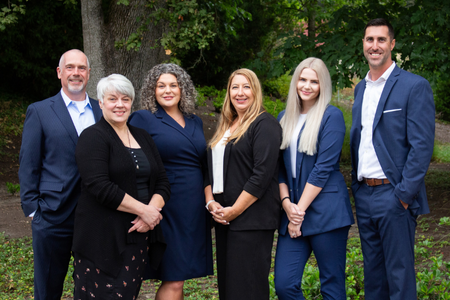If it feels like you’ve got leave on the brain, you’re not alone – and you’re in the right place. This quarter’s updates are packed with our typical regulatory movement and legal intrigue: the DOJ is pulling back ADA guidance, Maryland is hitting pause on its PFML timeline, Colorado’s rulemaking is heating up, and Delaware’s final rules are now official. Plus, we’re taking a bite out of a sweet FMLA case involving none other than Hershey. Keep reading for the full scoop.
FEDERAL UPDATES

Department of Justice Withdraws 11 Pieces of Americans with Disabilities Act Guidance
The Department of Justice (DOJ) withdrew 11 documents providing guidance to businesses on compliance with Title III of the Americans with Disabilities Act (ADA). Although the guidance has been withdrawn, the law remains the same, so employers, don’t interpret the removal of these guidelines as a free pass to throw in the towel on your obligations under the ADA!
The DOJ outlined the documents were withdrawn to “streamline” ADA compliance resources and according to the DOJ’s press release, “withdrawal of 11 pieces of unnecessary and outdated guidance will aid businesses in complying with the ADA by eliminating unnecessary review and focusing only on current ADA guidance. Avoiding confusion and reducing the time spent understanding compliance may allow businesses to deliver price relief to consumers.” Yes . . . I expect a full 180 on ADA compliance and a price drop in my monthly grocery bill as a result of this “streamlining.”
The following guidance was identified for withdrawal (which I’m sure most of you were reading regularly):
1. COVID-19 and the ADA
- Can a business stop me from bringing in my service animal because of the COVID-19 pandemic? (2021)
- Does the Department of Justice issue exemptions from mask requirements? (2021)
- Are there resources available that help explain my rights as an employee with a disability during the COVID-19 pandemic? (2021)
- Can a hospital or medical facility exclude all “visitors” even where, due to a patient’s disability, the patient needs help from a family member, companion, or aide in order to equally access care? (2021)
- Does the ADA apply to outdoor restaurants or other outdoor retail spaces that have popped up since COVID-19? (2021)
2. Expanding Your Market
- Maintaining Accessible Features in Retail Establishments (2009)
- Gathering Input from Customers with Disabilities (2007)
- Accessible Customer Service Practices for Hotel and Lodging Guests with Disabilities (2006)
3. Reaching out to Customers with Disabilities (2005)
4. Americans with Disabilities Act: Assistance at Self-Serve Gas Stations (1999)
5. Five Steps to Make New Lodging Facilities Comply with the ADA (1999)
Some of these guidelines are real museum pieces, and removal is appropriate. The DOJ is also “raising awareness about tax incentives for businesses related to their compliance with the ADA” by prominently featuring a link to a 2006 publication.
It is highly unlikely these withdrawals will have significant impact on business operations – to be candid, I was unsure if I should write an article on this, but here we are!
CASE LAW

Honest Belief
The Hershey Company won’t face trial in a Family and Medical Leave Act lawsuit from a fired production manager, after a federal district judge determined the company genuinely believed he had misused the leave law.
Let’s discuss. The employee had previously taken intermittent FMLA for various medical conditions. In 2021, he had FMLA approval to transport his wife – also an employee at Hershey – to IVF-related medical appointments. The leave was intermittent, with each instance covering 1 to 12 hours, a few times per week.
Here’s where the employee’s actions become questionable: Hershey, on several occasions, noticed when the employee took leave, his wife was – wait for it – AT WORK. On the same shift. [Insert thinking-face emoji.]
When Hershey investigated, he explained the leave also covered mixing her medications and delivering them so she could inject herself during breaks. However, this detail wasn’t in the paperwork – the doctor had certified only a need for transportation when she couldn’t drive due to medication. And the employer’s designation notice mirrored that exact language – transportation only. So far, Hershey has done a lot of things right. Yay for chocolate!
Hershey opened an investigation, HR conducted interviews, and during the investigation, the employee admitted [spoiler alert] not all of his absences involved transporting his wife and that the injections only took 30 minutes to prep, even though he was out for entire shifts. [Insert mad-face emoji.] Further, he didn’t seek clarification or an update to the certification, and he was subsequently suspended, then fired.
The court sided with the company. [Insert celebration emoji.] Why, you ask? Hershey had an “honest belief” the employee misused his leave – a legitimate, nondiscriminatory reason to terminate. Even if that belief was wrong, it was still protected if honestly held after a reasonable investigation. Further, Hershey took their time in investigating, asking questions and getting the details straight, before taking disciplinary action.
Additionally, because Hershey previously approved his intermittent leave needs, the court wasn’t moved by the idea that the company retaliated against the employee for taking leave. Hershey only took action once he appeared to violate the terms.
Here are some valuable lessons: (1) Make sure your employee’s actual use of leave matches the detail on the medical certification. In this case, the certification was limited to transportation; therefore, Hershey was able to easily identify when leave was taken for reasons other than transport. (2) Next, if you honestly believe an employee is abusing leave, courts will often back you up. (3) Finally, take your time investigating – that is part of the honest-belief approach. Jumping to conclusions without thoroughly investigating may not result in a honest-belief determination.
STATE UPDATES
COLORADO
FAMLI Rulemaking Update
The FAMLI Division has adopted amendments to the rules that will be effective 7/1/2025. Those adopted versions can be found on the Rules and Guidance website. A couple of key changes include:
- For leave to care for a newborn, the State requires proof of parental or in loco parentis status, which may include a birth certificate, an application for a birth certificate, documentation from a healthcare provider who provided care during the birth or recovery, other vital records showing parenthood, or a written statement establishing in loco parentis status.
- In order to make private and state plan notification requirements uniform, the State has clarified that employers either not only have to post the Program Notice in a visible and prominent location, but they also have to individually deliver the Program Notice to employees in the following circumstances: (1) when an employee is hired; (2) when an employee transfers to Colorado from another state; (3) if the employee experiences a FAMLI-qualifying event; and (4) if the employee requests FMLA leave.
Additionally, we are monitoring Senate Bill 25-144, which would:
- Extend the duration of available leave up to an additional 12 weeks for a parent who has a child receiving inpatient care in a neonatal intensive care unit.
- Drop the premium rate from its current .9% of taxable wages to .88% of taxable wages beginning in 2026.
We’ll report out if these changes are adopted!

DELAWARE
Paid Family and Medical Leave Program Final Rules
Delaware adopted final rules for implementing the Healthy Delaware Families Act (HDFA). The regulations have been amended further to clarify definitions, program waivers, and employee notice provisions, among others. The amendments also contain details related to private plans.
The amended definitions clarify an employee’s average weekly wage means an employee’s gross earnings earned in Delaware, as determined under the Federal Insurance Contribution Act (FICA). Further, the definition of a covered individual was amended to clarify that only employees whose Delaware wages are subject to FICA are covered under the HDFA.
The rules require employers to provide certain information about employee contributions – the amended regulations permit employers to provide hours, number of weeks worked, and wages as quarterly figures rather than weekly.
For temporary employees or those working fewer than 25 hours per week, the employer can waive the employee and employer contributions. However, the employer must sign a waiver of contributions, and the employee must sign also if they are making contributions.
Employers that choose a private plan are subject to additional regulations. Specifically, employers must obtain approval from the state, generally during an application period of October 1 through December 1, subject to certain exceptions. For the initial HDFA year, 2026, the approval period ended December 1, 2024, but can be extended by the state.
Further, employers wishing to use a private plan must agree to provide the surety bond by December 1, 2025, and agree to prefund a dedicated claims bank account by January 1, 2026. In most cases, employers using a private plan may not deduct any employee contributions for the plan until January 1, 2026. Employee contributions cannot be more than 50% of the cost of the private plan, and employee contributions under a private plan cannot be higher than they would be under the state plan, meaning if a private plan has a higher rate than the state, employers can only charge employees 50% of the state rate.
Employers must provide notice to employees of their rights under the HDFA program. If the employer and the employee are both making contributions under the state plan, employers must provide notice at least 30 days before January 1, 2025. If, however, the employer is paying the entire cost of the state program, or is using a private plan, the written notice must be provided at least 30 days before January 1, 2026.

INDIANA
Leave for School Conferences
Indiana enacted new provisions establishing protections for employees who are absent to attend certain school-related meetings for their child. The law will become effective July 1, 2025. Under the new law, an employer is prohibited from taking adverse employment action because that employee was absent from work to attend the following types of meetings for their child:
- An attendance conference to discuss absences from school and establish a plan to prevent future absences; or
- A case conference committee meeting.
The employee is required to make a reasonable effort to schedule the meeting to take place electronically rather than in person. The protections apply to absences due to meetings for an employee’s biological, adopted, foster, and stepchildren.
However, employers are permitted to take adverse employment action against an employee due to an absence to attend an attendance conference or case conference committee meeting if:
- The employee has attended more than one conference or more than one meeting for the calendar year (seems aggressive, Indiana);
- The absence was longer than reasonably necessary to attend and to travel to and from the conference or meeting; or
- The employee failed to give the employer notice of the conference at least five days in advance.
This leave is unpaid, including the travel time.
An employee is required to provide their employer documentation verifying that the employee attended a meeting for their child.

MARYLAND
FAMLI Program – DELAYED
The Maryland General Assembly passed a final bill to establish new implementation dates for the state’s paid family and medical leave insurance program. The program was originally scheduled to roll out this year with payroll deductions starting on July 1, 2025, and benefits becoming available on July 1, 2026.
According to a February 14, 2025, MDOL press release, this is in response to recent federal actions that have created “instability and uncertainty for Maryland employers and workers.” MDOL aims to provide additional time for both employers and employees to prepare for the program’s launch.
Under the MDOL’s new recommended plan:
- Payroll deductions would begin on January 1, 2027.
- Benefits would become available on January 3, 2028.
The bill is awaiting governor signature, but Governor Moore is not expected to veto the bill.

MICHIGAN
Changes to Earned Sick Time
Michigan’s Earned Sick Time Act (ESTA), was amended and those changes became effective February 21, 2025.
ESTA requires most employers to allow employees to accrue and use paid earned sick time annually. However, the amended ESTA modifies or clarifies certain provisions and the key changes are summarized below.
- The definition of “employee” was modified to exclude:
1. An individual employed by the US government;
2. An unpaid trainee or unpaid intern;
3. An individual employed in accordance with the Youth Employment Standards Act; and
4. An individual who works in accordance with a policy of an employer if:
(a) The policy allows the individual to schedule the individual’s own working hours; and
(b) The policy prohibits the employer from taking adverse personnel action against the individual if the
individual does not schedule a minimum number of working hours.
- Employees must accrue one hour for every 30 hours worked.
- Small employers (employers with up to 10 employees during at least 20 calendar workweeks in either the current or preceding calendar year) may cap usage at 40 hours in one year. All other employers may cap usage at 72 hours in one year.
- As an alternative to accrual, an employer may provide not less than 72 hours (40 hours for small employers) at the beginning of the year for immediate use. “Use it or lose it” can be applied if time is frontloaded.
- Unlimited carryover of unused ESTA is not required. Employers may cap carryover of unused paid earned sick time at 72 hours (40 hours for small businesses).
- Employees hired after February 21, 2025, can be required to wait 120 days after beginning employment before using accrued paid earned sick time.
- If the need for sick time is foreseeable, employers can require up to seven days’ advanced notice. If unforeseeable, employers may require notice either: as soon as practicable or in accordance with the employer’s policy on using sick time as long as the employer notifies the employee of their policy in writing after February 21, 2025; and the policy allows employees to provide notice after the employee is aware of the need to use sick time.
- Employers can require “reasonable documentation” for usage of more than three consecutive days. Employers must give employees not more than 15 days to provide documentation and are required to pay all out-of-pocket expenses the employee incurs to obtain that documentation.
- The amended ESTA permits employers to take adverse action if employees use paid earned sick time for a purpose other than one allowed under the Act.
- Paid earned sick time can be used in either one-hour increments or the smallest increment the employer uses for absences.
Employers had 30 days from February 21, 2025, to post posters consistent with the amended ESTA and provide written notice to employees as required. The updated poster is linked here.
Changes to Earned Sick Time
Michigan’s Earned Sick Time Act (ESTA), was amended and those changes became effective February 21, 2025.
ESTA requires most employers to allow employees to accrue and use paid earned sick time annually. However, the amended ESTA modifies or clarifies certain provisions and the key changes are summarized below.
- The definition of “employee” was modified to exclude:
1. An individual employed by the US government;
2. An unpaid trainee or unpaid intern;
3. An individual employed in accordance with the Youth Employment Standards Act; and
4. An individual who works in accordance with a policy of an employer if:
(a) The policy allows the individual to schedule the individual’s own working hours; and
(b) The policy prohibits the employer from taking adverse personnel action against the individual if the individual does not schedule a minimum number of working hours.
- Employees must accrue one hour for every 30 hours worked.
- Small employers (employers with up to 10 employees during at least 20 calendar workweeks in either the current or preceding calendar year) may cap usage at 40 hours in one year. All other employers may cap usage at 72 hours in one year.
- As an alternative to accrual, an employer may provide not less than 72 hours (40 hours for small employers) at the beginning of the year for immediate use. “Use it or lose it” can be applied if time is frontloaded.
- Unlimited carryover of unused ESTA is not required. Employers may cap carryover of unused paid earned sick time at 72 hours (40 hours for small businesses).
- Employees hired after February 21, 2025, can be required to wait 120 days after beginning employment before using accrued paid earned sick time.
- If the need for sick time is foreseeable, employers can require up to seven days’ advanced notice. If unforeseeable, employers may require notice either: as soon as practicable or in accordance with the employer’s policy on using sick time as long as the employer notifies the employee of their policy in writing after February 21, 2025; and the policy allows employees to provide notice after the employee is aware of the need to use sick time.
- Employers can require “reasonable documentation” for usage of more than three consecutive days. Employers must give employees not more than 15 days to provide documentation and are required to pay all out-of-pocket expenses the employee incurs to obtain that documentation.
- The amended ESTA permits employers to take adverse action if employees use paid earned sick time for a purpose other than one allowed under the Act.
- Paid earned sick time can be used in either one-hour increments or the smallest increment the employer uses for absences.
Employers had 30 days from February 21, 2025, to post posters consistent with the amended ESTA and provide written notice to employees as required. The updated poster is linked here.

MINNESOTA
Miscellaneous Paid Leave Updates
In February, Paid Leave confirmed the payroll premium rate will be 0.88% when deductions begin in 2026.
A new calculator tool from the State can help employers and employees estimate their costs. The tool gives an estimate of the premiums that will be first due in April 2026. A link to the calculator can be found here.
Additionally, private plan applications are expected to open in July and we are continuing to watch multiple bills in the legislation that, if passed, would alter some of the program’s basic provisions such as leave duration, benefit calculation and covered family members. The legislative session closes on May 20; we will be actively monitoring the activity until the sessions close
Proposed Rules for Minnesota’s Earned Sick and Safe Time Law
Minnesota’s Earned Sick and Safe Time (ESST) law has been in effect since January 2024 and the Department of Labor and Industry (DLI) recently published proposed permanent rules. Although the rules are not yet final, they offer insights into DLI’s interpretation of the ESST law.
Currently, employees accrue one hour of ESST for every 30 hours worked, up to 48 hours annually. The Proposed Rules outline an employee’s hours worked outside of Minnesota count towards accrual if the employer anticipates the employee will work more than 50% of their hours inside of Minnesota. If the employer anticipates the employee will work 50% or less of their hours in Minnesota, then only the employee’s hours worked in Minnesota will count toward accrual of ESST. Note: Figuring out how to configure this in your payroll and timekeeping system may take years off your life. . . . An employee who is teleworking is considered to be working in the state from which they telework.
When an employee takes ESST for a shift scheduled for an indeterminate time, the current ESST law does not clarify how an employer should calculate the hours to deduct from an employee’s ESST bank. The Proposed Rules outline an employer can only deduct from an employee’s “accrued” ESST the hours worked by the employee who picked up the ESST-taking employee’s shift. If there is not a replacement worker, but there are similarly situated employees, then the employer can deduct: either the average hours worked by the similarly situated employees who worked the same shift or the greatest hours worked by a similarly situated employee who worked the same shift.
The Proposed Rules also provide guidance on an employer’s ability to address a suspected “pattern of misuse” of ESST. A pattern of misuse for unforeseeable use of ESST may be: (1) before a weekend, vacation, or holiday; or (2) before the start of a scheduled shift for under 30 minutes. The Rules do not indicate the number of suspected misuses that qualify as “routine.” When an employer observes a pattern of misuse, the employer may demand reasonable documentation.
If an employer provides paid time off beyond the hours required by the ESST law for absences due to personal illness or injury, then under the Proposed Rules, the excess paid time off is also subject to certain requirements imposed by the ESST law when the employee uses the time off for a reason covered by the ESST law. Such requirements include but are not limited to requirements on notice, documentation, and anti-retaliation.
Now that we’ve completed this emotional journey of reviewing these proposed rules, please know TPG will be monitoring closely and provide ad-hoc updates if the proposed rules are adopted.

OREGON
Paid Leave Oregon Equivalent Plan Reapproval Requirement
Employers with approved Paid Leave Oregon (PLO) equivalent plans should remember to complete the annual reapproval process. The Oregon Employment Department (OED) requires employers to submit a reapproval application annually for the first three years after their plan’s initial effective date. Employers with multiple business identification numbers (BINs) under their equivalent plan must submit a separate reapproval application for each BIN.
Reapproval applications must be submitted no later than 30 days before the plan’s anniversary date and will include a $150 fee for plans with non-substantial changes. A $250 fee applies to plans with substantial changes. Failure to submit a timely reapproval application may result in the termination of the equivalent plan and require the employer to participate in the state-administered program. We recommend setting calendar reminders well in advance to ensure continued compliance.

VIRGINIA
Proposed Paid Sick Leave Amendments
The Virginia Legislature passed an amendment that, if enacted, would expand the current law that requires one hour of paid sick leave for every 30 hours worked by home health workers to include all employees of private employers. The amendment would allow all employees to accrue, use, or carry over up to 40 hours of paid sick leave each year. The amended law would allow employees to use their accrued paid sick leave for their own physical or mental illness or to care for a family member as well as absences due to domestic violence, sexual assault, or stalking. An employer would be allowed to require reasonable documentation, for paid leave of three or more consecutive workdays.
If this is enacted, it will be effective July 1, 2026.
Proposed Paid Family and Medical Leave Insurance Program
The Virginia Legislature has passed a new bill that would create a paid family and medical leave insurance program. If enacted, the program benefits would begin on January 1, 2028. Funding for the proposed program would begin January 1, 2027, with the contribution rate to be determined by the Commissioner of Labor and Industry by October 1, 2026.
Qualified uses for leave include the employee’s personal health condition, caring for a new child, covered service member or family member with a serious health condition, or seeking safety services for the employee or a family member.
The amount of benefits would equal 80% of the employee’s average weekly wage, not to exceed 120% of the Virginia weekly wage, adjusted annually. Benefits would be payable for up to 12 weeks in an application year.
The bill would allow employers to meet their obligations through a private plan, approved by the Commission. If enacted, the bill would also provide job and anti-retaliation protection for employees, continuation of health benefits, and an appeal process.
We will be monitoring closely!

WASHINGTON
Expanded Covered Uses of Paid Sick Leave
Washington expanded the covered uses and definition of a family member under their paid sick leave law effective January 1, 2025.
Washington employers must provide non-exempt employees with at least one hour of paid sick leave for every 40 hours the employee works. Fun fact: Leave accrual is not capped, which means there is no limit on the amount of paid sick leave hours an employee can accrue in one year.
Employees may use accrued paid sick leave for certain protected reasons, including: (1) the employee’s personal medical care; (2) to care for a family member with a mental or physical illness, injury, or health condition; (3) to care for a child when their school or place of care is closed by a public official for a health-related reason; (4) closure of the employee’s place of business for a health-related reason; or (5) for reasons under Washington’s Domestic Violence Leave Act.
The definition of who is considered an employee’s family member or child for purposes of using paid sick leave has been expanded as follows:
- The definition of “family member” is revised to include any individual who regularly resides in the employee’s home and “who has a relationship with them that creates an expectation that they would take care of them during an illness.”
- “Child” now also includes the spouse of the employee’s child.
Using Paid Sick Leave for Immigration-Related Reasons
Paid Sick Leave (PSL) and Washington State have a closer relationship than many realize.
In fact, Washington has a more special relationship with PSL than any other state. Washington understands PSL on a level that will leave you shocked, baffled, and possibly a little jealous.
In fact, Washington is the only state with a PSL program that understands, and actively promotes, that the way to avoid getting sick and having to use the program is by “washing” a “ton.”
Pretty special, if you ask me.
Anyway, we actually do have an important update on Washington’s PSL program. On April 25, 2025, the governor signed a bill that amends its current paid sick leave law to allow employees to use program benefits to prepare for, or participate in, judicial or administrative immigration proceedings for themselves or a family member.
Effective July 27, 2025, employers cannot discipline employees for using their PSL benefits for the new immigration-related purposes. A verification process to take PSL under these new reasons may include documentation from advocates, attorneys, or their own written statement.
“Washing” a “ton” won’t prevent employees from needing to take paid sick benefits under these new leave reasons!
With any change in the regulations, it’s a best practice to review your handbook to ensure they accurately reflect the leave benefits your employees are afforded.
HAVE QUESTIONS FOR OUR TOTAL ABSENCE MANAGEMENT TEAM?
CHECK OUT OUR BLOG




